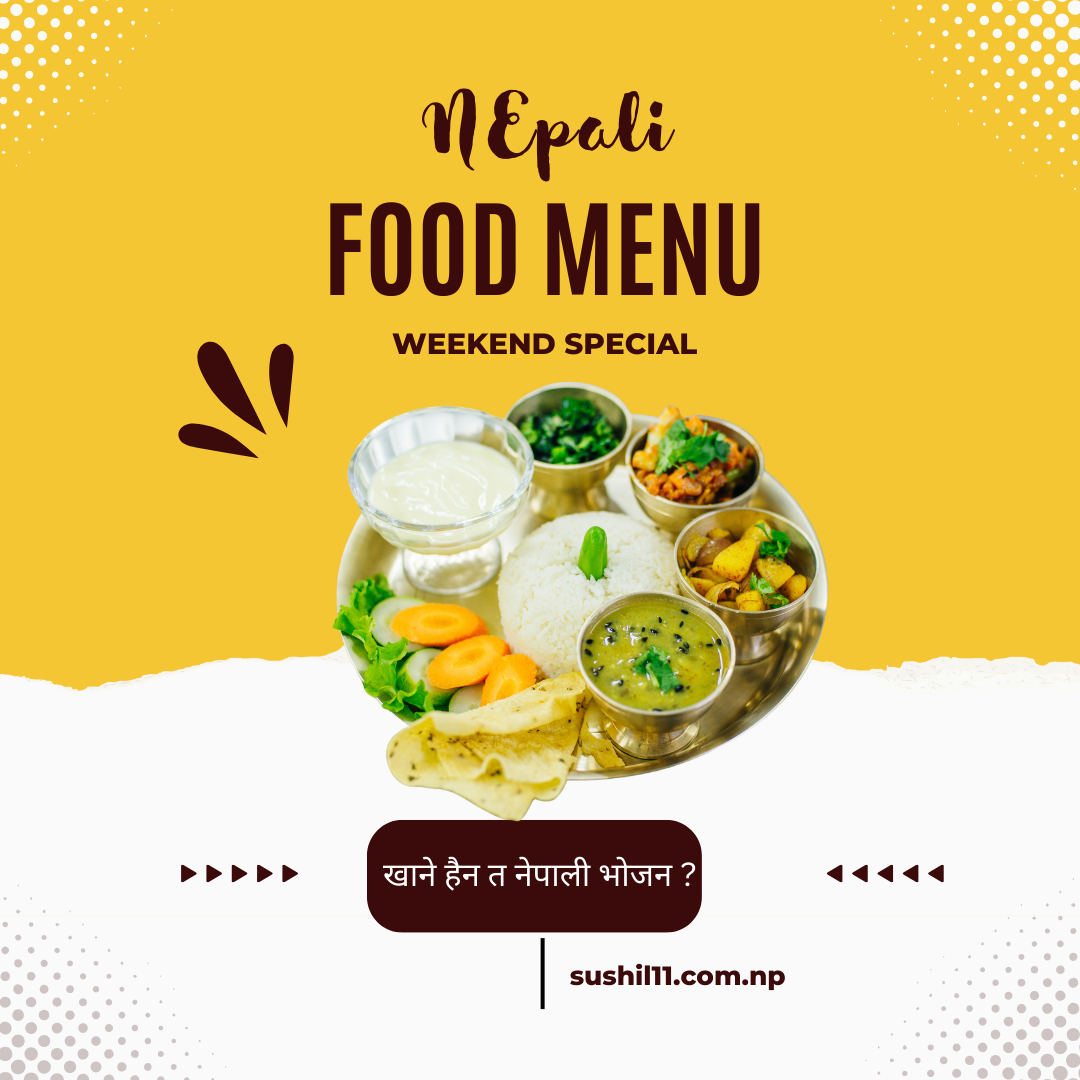Food you must try in Nepal
Nepalese food is an alluring smorgasbord, influenced by the varied geography and ethnicity within the country. Nepalese food is an alluring smorgasbord of food in Nepal, influenced by the varied geography and ethnicity within the country. Preparing and serving dal bhat, a steady staple food, involves combining lentil soup and rice with different varieties of seasonal vegetables, pickles, and curried meats. People in Nepal consider ‘dal-bhat’ as more than just a staple food; it represents their harmony, bond, and tradition. Diners can enjoy delicious morsels, including momo, which are juicy steamed dumplings filled with spiced meat or vegetables, and are served alongside a chutney made fiery with tomatoes.
Daal Bhat: A Staple of Food in Nepal

If you ask any Nepali what the basic food is in Nepal, it’s like asking loyalists what they eat after a war—it’s always Dal Bhat. The name can be translated as “lentils and rice.” Soup that most often accompanies basic Nepalese family meals.
Apart from being one of the many appetizing meals, Daal Bhat is a cornerstone of food in Nepal and has a culture that connects the Nepalese. There are curries of meat like chicken or goat and they are served with vegetables that are in season, yogurt and pickles. In the countryside of Nepal, Dal Bhat is the working schedule meal that gives farming and construction workers strength to work hard. It is a meal that is complete for all the body’s needs as it contains proteins, carbohydrates, and vitamins. A different variation of dal bhat is served depending on the region of the country. In the Terai, the lentil soup may be more a super thin soup and much spicier and uptight in the hills.
History of Dal Bhat
There are no definite dates attributed to the history of dal bhat, as it has been traced back to the history of Annawars more than thousands of years ago in the lives of the Nepalese farmers with rice becoming the accent. Rice has always been a crucial crop to the people’s agriculture due to the rice-producing regions stretching out to the southern flatlands of Nepal. And therefore, it is logical and natural that dal, which is produced from tops lentils grown within the country, is served as an accompaniment. Few men have worked the elements of this dish in Nepali history, but thereby colluding it developed into a national—or, at least, a countrywide applicable standard.
Momo: A Delicious Part of Food in Nepal

Momo is yet another culinary masterpiece in the realm of food in Nepal that is cherished in the traditional gastronomy of Nepal. The dumplings include minced meat, usually consisting of buffalo, chicken, or pork meat, and are seasoned with garlic, ginger, and Nepali spices. There are vegetable momos as well, with fillings such as cabbage, carrots, or onions. Momos can be fried or steamed, and they come along with achar, which is a preferred chili and tomato sauce.
How Momo is Made?
The authentic delicacy of Nepali cuisine Momo is a dumpling available all over the country. To begin this, a smooth, soft dough is prepared with all purpose flour and water, which is then kneaded. The filling is highly varied, where one can place minced chicken meat, buffalo or pork, as well as some vegetarian options with cabbage, carrots and onions. These ingredients are then flavoured with ginger, garlic, cumin, and coriander, amongst others, to enhance taste. The dough is cut into smaller pieces, rolled, filled with the filling and folded and sealed as dumplings. Finally, the momos are placed in a steamer for 10-15 minutes, during which time the momos are completely cooked and served hot, mostly with spicy chutney.
History of Momo
Momo originated from Tibet and was introduced to Nepal through trade. Over time, Nepali momo adapted, incorporating new tastes and spices, becoming a staple in every Nepali home and restaurant.
Sel Roti: A Sweet Treat in Food in Nepal

People prepare Sel Roti, a popular traditional Nepali sweet bread, during festival occasions like Dashain and Tihar. It is a beloved example of sweet food in Nepal prepared during festive occasions. This sweet, deep-fried, rice-based, ring-shaped bread consists of rice flour, sugar, ghee, and milk. The cook pours the batter in the shape of a circle into hot oil and fries it until the outer side is crispy and the inner side is softer.
How is sel roti made?
To prepare Sel Roti, soak rice, preferably basmati, overnight and then pound it into a very soft batter. Add sugar and ghee to the batter. Fry the batter in a round shape, creating a ring, while applying skill. The outside of the Sel Roti becomes lightly coated, while the inside remains soft. It is usually served with a curry dip of yogurt, or alu ko achar.
History of Sel Roti
Sel Roti has a long history associated with Nepalese festivals and customs. Family members customarily prepare this kind of food to give away at religious occasions, representing joy. Making it involves skillful hand-to-hand coordination, and many households in Nepal consider it one of the most valued and practiced activities when it comes to Sel Roti.
Thakali Khana: Traditional Food in Nepal
The Thakali community of the Mustang subregion of northwestern Nepal actually serves Thakali Khana as a traditional form of meal. This meal contains rice or barley, a soup of lentils and several other vegetable curries, vegetable pickles, and fermented vegetables. Their food has a sharp taste, owing to the presence of agastache and timur, among other ingredients.
Types of Thakali Food.
A typical Thakali Khana set includes rice and lentils accompanied by not only sauteed greens, spicy rakhi or radish pickles, and chosen curry with meat or vegetables. Thakali food is also found to have more spice and hearty taste than the other dishes in this region. The use of gundruk (fermented leafy greens) is also imperative as it adds distinct sourness to the dish.
History of Thakali cuisine
The Thakali people used to control the trade routes that passed through the Himalayan mountains, which allowed them to obtain many kinds of spices and other ingredients. The geography of the high altitude areas where they live also influences their food, as the cold climate leads them to enjoy thick, warm dishes that melt their hearts.
Newari Food: Unique Flavors of Food in Nepal
Nepali cuisine has a lot to offer regarding dishes developed by the Newar community of the Kathmandu Valley. People well know Newari food for its remarkably thick and rich taste and its use of lentils, beef, and beaten rice.
Newari Meals You’ll Come Across in Nepal
Chatamari: Commonly known as the Nepali pizza, is a rice based Indian flat bread with ground meat and many more items.
Yomari: Yomari is a soft dumpling prepared in steam, filled with coconut inner sauce, especially during festivals.
Bara: Bara is made of black pulse lentils and is served as a pancake, garnished with egg or sometimes fine pieces of chicken.
Newari Food History
The Newars developed Newari food in the Kathmandu Valley, which has been a center of trade and citizenship. The ingredients which were available to the valley and newark the source of the creative processes also shaped the food.
Gundruk: A Key Ingredient in Food in Nepal
Gundruk is a sour Asian dish that contains green vegetables that are fermented and sundried for use in further preparation of soups and also settles for stew preparation. A described gundruk is rather sour and mildly tart, outperforming dal bhat on the side, or using it as a condiment to various curries.
How is Gundruk Made?
Mustard, radish or cauliflower leaves are slightly wilting first and kept for fermenting in an earthen pot. The leaves are then dried in the sun for several days after they have been fermented. Gundruk is a preserved food and is particularly favorable for its ability to conserve foodstuffs for winter.
History of Gundruk
The practice of fermenting greens seems to be ancient in Nepal, especially in the hilly regions, where the supply of fresh vegetables is unable to last for the winter. Instead of leaving people with burning stomachs, Gundruk ensured that families could survive the winters and, most importantly, have access to vital nutrients throughout the year. Best Drinks in Nepal There is also a wide range of drinks from the local or cultural perspective which are traditionally and locally made within the terrains of Nepal. Dzhango, cooling liqueurs, warm soothing herbal teas the list goes on for the drinks native of Nepal. Places in Katmandu or mountain villages are no where the less and at these places too, these drinks and all other beverages that encompass the north Indian hospitality filled with Tibetan spicy curry will enhance the dexterity of Nepali food culture.
Rakshi.
Rakshi, a regional Nepali alcohol, distillers produce in the countryside using rice, millet, or wheat. It has a distinct taste and they usually serve it during festivals, religious events, or other occasions. Being very clear and tasty, it can also be related to whiskies and vodkas. Among ethnic groups like Gurung, Magar, and Tamang, people consume Rakshi, and it has a rich cultural background.
How is rakshi made?
Local equipment is used to ferment available grains and then distill them, such as the traditional pot still. The process of brewing and distilling Rakshi is a skill that has been practiced for generations, typically in home settings.
Aila.
Another of the alcoholic drinks is Aila, which is also a traditional beverage, the Newars especially hold it in high regard. Made by the fermentation of rice, aila is similar to rakshi but has a tendency to have a more smooth, silky mouthfeel with a touch of sweetness. Aila is a heavy drink that people serve in small portions, and they generally use it for festive occasions, significant issues, or family events. The Newar community in Kathmandu Valley especially cherishes brewing Aila; however, they regard this drink as highly spiritual in nature and use it in most Newari festivals.

